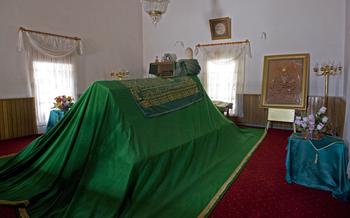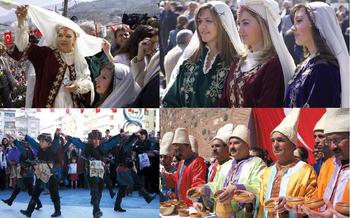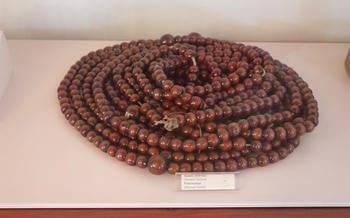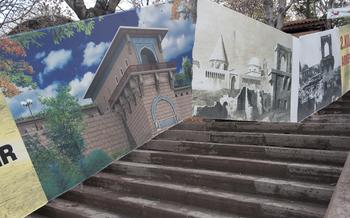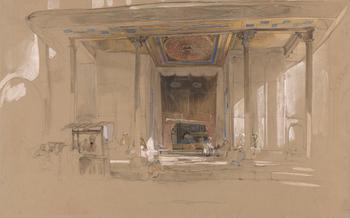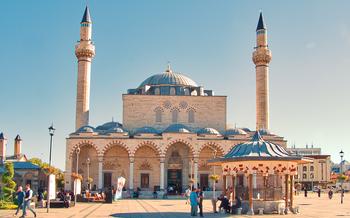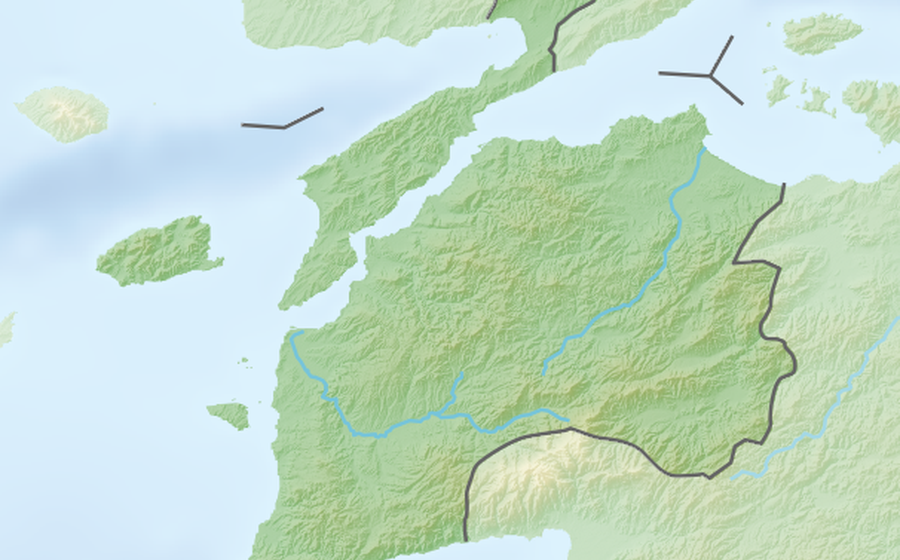
Gelibolu Mevlevihanesi
- History of Gelibolu Mevlevihanesi
- Mevlevi Order in Çanakkale
- History of the Building
- Architectural Features
- Location and How to Get There
- Opening Hours and Admission Fees
- Exploring the Mevlevihanesi
- The Semah Ceremony
- The Museum
- The Library
- The Dervish Cells
- The Garden
- The Tomb of Sheikh Edebali
- Shopping for Souvenirs
- Dining Nearby
- Accommodation Options
- Additional Tips for Visitors
- Insider Tip: Experience the Whirling Dervishes Ceremony
History of Gelibolu Mevlevihanesi
The Gelibolu Mevlevihanesi, a historical and cultural landmark in Çanakkale, Turkey, holds significant importance as a center of spirituality and mysticism. It is one of the many Mevlevihanes, or dervish lodges, established by the Mevlevi Order, a Sufi order founded by the renowned Persian poet and mystic, Rumi.
Mevlevi Order in Çanakkale
The Mevlevi Order, also known as the Whirling Dervishes, has a rich history in Çanakkale, dating back to the 15th century. The order's presence in the region was instrumental in spreading the teachings of Rumi and promoting spiritual enlightenment among the local population. The Gelibolu Mevlevihanesi, built in the 18th century, served as a central hub for the Mevlevi community in Çanakkale, providing a sacred space for religious rituals, gatherings, and spiritual growth.
History of the Building
The Gelibolu Mevlevihanesi, constructed in 1757 during the Ottoman period, stands as a testament to the architectural prowess and artistic sensibilities of the time. The complex comprises several structures, including a Semahane (ritual hall), a mosque, a library, a museum, and living quarters for dervishes. The Semahane, the heart of the Mevlevihanesi, is a stunning octagonal hall adorned with intricate carvings, colorful tiles, and a high dome that allows natural light to illuminate the interior.
Architectural Features
The Gelibolu Mevlevihanesi showcases a unique blend of Ottoman and Seljuk architectural styles. The exterior facade is characterized by its sturdy stone walls, arched entrances, and elegant minarets. The interior spaces, on the other hand, display a harmonious fusion of Islamic and Turkish motifs, with intricate tilework, calligraphy inscriptions, and decorative plasterwork adorning the walls and ceilings. The complex's overall design reflects the Mevlevi Order's emphasis on aesthetics and spirituality, creating a serene and inspiring environment for religious practices and contemplation.
Location and How to Get There
Address:
The Gelibolu Mevlevihanesi is located at the following address:
Gelibolu Mevlevihanesi
Mevlevihane Cd. No:15
17600 Gelibolu/Çanakkale
Turkey
Getting There by Public Transportation:
From Çanakkale city center, visitors can take the municipal bus line number 1, which departs from the Otogar (bus station) and stops right in front of the Mevlevihanesi. The bus ride takes approximately 45 minutes.
Getting There by Car:
From Çanakkale city center, visitors can drive to the Gelibolu Mevlevihanesi in about 30 minutes. The Mevlevihanesi is well-signposted from the main road. There is a parking lot available for visitors.
Opening Hours and Admission Fees
The Gelibolu Mevlevihanesi is open to the public every day of the week, except for Mondays, from 8:30 am to 5:00 pm. Admission fees are quite affordable, with regular tickets costing 10 Turkish Lira (around 50 USD) and discounted tickets costing 5 Turkish Lira (around 0.75 USD) for students and senior citizens.
Guided tours are available upon request and typically last for around 30-45 minutes. The cost of a guided tour is 20 Turkish Lira (around 3 USD) per person.
It's worth noting that the Mevlevihanesi may occasionally be closed for special events or maintenance, so it's always a good idea to check the official website or call ahead before planning your visit.
Exploring the Mevlevihanesi
What are the highlights of the Mevlevihanesi?
The Gelibolu Mevlevihanesi is a beautiful and historic building that is home to a number of interesting exhibits and attractions. Some of the highlights include:
- The Semahane, which is the main hall where the Mevlevi dervishes performed their Semah ceremonies. The Semahane is decorated with beautiful tiles and has a high ceiling that is supported by wooden columns.
- The Museum, which houses a collection of artifacts related to the Mevlevi Order, including costumes, musical instruments, and manuscripts.
- The Library, which contains a collection of books and manuscripts on a variety of topics, including religion, history, and philosophy.
- The Dervish Cells, which are small rooms where the dervishes lived and slept. The cells are decorated with simple furnishings and have a small window that looks out onto the garden.
- The Garden, which is a peaceful and tranquil space that is home to a variety of plants and flowers. The garden is a popular spot for visitors to relax and take a break from the hustle and bustle of the city.
How long should you expect to spend exploring the Mevlevihanesi?
Visitors can expect to spend around 1-2 hours exploring the Gelibolu Mevlevihanesi. This will give them enough time to see all of the exhibits and attractions, and to learn about the history and culture of the Mevlevi Order.
What can you see and do there?
In addition to exploring the exhibits and attractions, visitors can also participate in a number of activities at the Gelibolu Mevlevihanesi. These activities include:
- Attending a Semah ceremony, which is a traditional Mevlevi dance that is performed by a group of dervishes. The Semah ceremony is a beautiful and moving experience that is not to be missed.
- Taking a guided tour of the Mevlevihanesi. A guided tour is a great way to learn more about the history and culture of the Mevlevi Order.
- Relaxing in the garden. The garden is a peaceful and tranquil space that is perfect for taking a break from the hustle and bustle of the city.
- Browsing the gift shop. The gift shop sells a variety of souvenirs, including books, postcards, and handicrafts.
The Semah Ceremony
The Semah ceremony is a whirling dervish ritual that is one of the most iconic and mesmerizing performances in the world. It is a spiritual practice that involves the dervishes spinning in a circular motion, representing their connection to the divine. The ceremony is performed to the accompaniment of live music and chanting, and it is a truly unforgettable experience.
The Semah ceremony is held every Saturday evening at the Gelibolu Mevlevihanesi. Visitors are welcome to attend the ceremony, but it is important to be respectful and to dress appropriately. Women should cover their heads with a scarf or shawl, and men should wear long pants and a collared shirt.
The ceremony begins with the dervishes entering the Semahane, the whirling dervish hall. They line up in two rows and bow to the Sheikh, who is the spiritual leader of the Mevlevi Order. The Sheikh then recites a prayer, and the dervishes begin to spin.
The dervishes spin in a counter-clockwise direction, their arms outstretched and their heads tilted back. They spin for about 10 minutes, and the speed of their spinning gradually increases. As they spin, the dervishes enter a trance-like state, and they are said to be connecting with the divine.
The Semah ceremony is a beautiful and moving experience, and it is a must-see for anyone visiting the Gelibolu Mevlevihanesi.
The Museum
The Gelibolu Mevlevihanesi Museum is located within the complex and houses a collection of artifacts and exhibits related to the history of the Mevlevi Order and the Gelibolu Mevlevihanesi itself. Visitors can explore displays of traditional Mevlevi musical instruments, such as the ney (reed flute) and kudüm (drum), as well as clothing, manuscripts, and other objects used by the dervishes.
The museum also features a section dedicated to the life and teachings of Mevlana Celaleddin Rumi, the founder of the Mevlevi Order. Visitors can learn about Rumi's philosophy of love, tolerance, and unity, and how his teachings influenced the development of the Mevlevi tradition.
Guided tours of the museum are available for visitors who wish to learn more about the exhibits and the history of the Mevlevi Order. Tours are typically conducted in Turkish, but English-language tours can be arranged upon request.
The Library
The library at the Gelibolu Mevlevihanesi is a treasure trove of knowledge and spirituality. It houses a vast collection of books and manuscripts, many of which are centuries old. The collection includes works on a wide range of subjects, including religion, philosophy, history, and literature.
Of particular note is the collection of Mevlevi manuscripts, which are among the most important in the world. These manuscripts contain the teachings of the Mevlevi Order, as well as the poetry and music of Rumi, the founder of the order.
The library is open to the public, and visitors are welcome to browse the collection and read the books. However, there are some restrictions on who can borrow books from the library. Only students and scholars who are affiliated with a university or research institution are allowed to check out books.
Despite the restrictions, the library at the Gelibolu Mevlevihanesi is a valuable resource for anyone who is interested in learning more about the Mevlevi Order and its rich history.
The Dervish Cells
The dervish cells, also known as hücre, are one of the most distinctive features of the Gelibolu Mevlevihanesi. These small, windowless rooms were where the dervishes lived and slept. They are typically very simple, with only a few basic furnishings, such as a bed, a desk, and a prayer rug. Some of the cells also have small fireplaces, which were used to keep the dervishes warm during the winter months.
Visitors to the Mevlevihanesi can tour the dervish cells and get a glimpse into the lives of the dervishes who lived there. The cells are all very similar, but each one has its own unique character. Some of the cells are decorated with beautiful calligraphy and artwork, while others are more plain and simple.
There are two types of dervish cells at the Mevlevihanesi: single cells and double cells. The single cells were used by dervishes who had attained a higher level of spiritual development, while the double cells were used by dervishes who were still in training.
The dervish cells are a reminder of the simple and humble lifestyle that the dervishes lived. They are also a testament to the dedication and devotion of the dervishes to their faith.
The Garden
The garden of the Gelibolu Mevlevihanesi is a serene and tranquil space, providing a peaceful retreat from the hustle and bustle of the city. It is a place where visitors can come to relax and reflect, surrounded by the beauty of nature. The garden is home to a variety of plants and flowers, including roses, jasmine, and lavender, which fill the air with their sweet fragrance. Visitors can stroll along the garden paths, admiring the colorful blooms and the lush greenery. The garden is also a popular spot for birdwatching, as many different species of birds can be seen flitting among the trees and flowers.
The Tomb of Sheikh Edebali
Sheikh Edebali was a renowned Islamic scholar and spiritual guide who lived during the 13th century. He is best known as the mentor and father-in-law of Osman I, the founder of the Ottoman Empire. Sheikh Edebali's teachings and guidance are credited with shaping Osman's character and contributing to the establishment of the Ottoman dynasty.
His tomb is located within the grounds of the Gelibolu Mevlevihanesi, a testament to the deep respect and admiration held for him by the Mevlevi Order. Visitors to the Mevlevihanesi can pay their respects at his tomb, which is a place of pilgrimage for many Muslims and a symbol of the deep spiritual heritage of the region.
Shopping for Souvenirs
After exploring the Gelibolu Mevlevihanesi, visitors can head to the nearby shops to purchase souvenirs as a memento of their visit. Various shops in the area sell traditional Turkish handicrafts, carpets, pottery, jewelry, and other souvenirs. Visitors can find unique items such as hand-painted ceramics, intricate carpets, and beautiful jewelry made with precious stones and metals.
In addition to these traditional souvenirs, visitors can also find local specialties such as Turkish delight, lokum, and baklava. These sweet treats are a popular choice among visitors and make excellent gifts for friends and family back home.
For those looking for something truly special, the Gelibolu Mevlevihanesi Museum Shop offers a variety of unique items, including replicas of Mevlevi musical instruments, books on Mevlevi culture and history, and other items related to the Mevlevi Order.
Dining Nearby
There are several dining options available near the Gelibolu Mevlevihanesi, catering to a variety of tastes and budgets. Visitors can find everything from traditional Turkish cuisine to international fare within walking distance of the Mevlevihanesi. For those looking for a quick bite, there are several cafes and bakeries offering sandwiches, pastries, and coffee. If you're in the mood for a leisurely meal, there are several restaurants serving both traditional Turkish dishes and international cuisine.
One of the must-try dishes in Çanakkale is "Çanakkale Çardak Köfte", a local specialty made with meatballs cooked in a tomato-based sauce and served with rice or bulgur. Another popular dish is "Gelibolu Lahmacun", a type of Turkish flatbread topped with minced meat, vegetables, and spices. For seafood lovers, there are several restaurants serving fresh fish and seafood caught from the nearby Sea of Marmara.
Accommodation Options
The Gelibolu Mevlevihanesi is surrounded by a variety of accommodation options to suit different budgets and preferences. Visitors seeking a luxurious stay can opt for the five-star Çanakkale Otel, which offers breathtaking views of the Dardanelles Strait and modern amenities. For a more budget-friendly option, the three-star Gelibolu Hotel provides comfortable rooms with basic amenities.
Those seeking a unique and immersive experience can choose to stay at the Mevlevihane itself. The Mevlevihane offers a limited number of rooms that have been converted into guest rooms, allowing visitors to experience the atmosphere of a working Mevlevi lodge.
No matter what your budget or preferences, you're sure to find the perfect accommodation near the Gelibolu Mevlevihanesi.
Additional Tips for Visitors
When visiting the Gelibolu Mevlevihanesi, it is important to be respectful of the religious and cultural significance of the site. Visitors should dress modestly and avoid wearing shorts, tank tops, or other revealing clothing. It is also important to be mindful of noise levels and to avoid disturbing other visitors or the dervishes who may be praying or meditating.
For those interested in learning more about the Mevlevi Order or the history of the Mevlevihanesi, guided tours are available. These tours are led by knowledgeable guides who can provide insights into the unique history and traditions of the Mevlevi dervishes.
It is worth noting that the Mevlevihanesi is a working monastery, and as such, there may be times when certain areas are closed to visitors. It is always a good idea to check with the staff before exploring the complex to ensure that you do not disturb any religious activities.
Insider Tip: Experience the Whirling Dervishes Ceremony
For a truly unforgettable experience, make sure to attend the Semah ceremony, a mesmerizing ritual performed by the whirling dervishes of the Mevlevi Order. During this sacred dance, the dervishes rotate gracefully while wearing long, flowing skirts, symbolizing their connection to the divine. The ceremony is a breathtaking spectacle that showcases the spiritual essence of Sufism and offers a glimpse into the rich cultural heritage of Turkey. Check the Mevlevihanesi's website or inquire at the information desk for the schedule of upcoming ceremonies.

